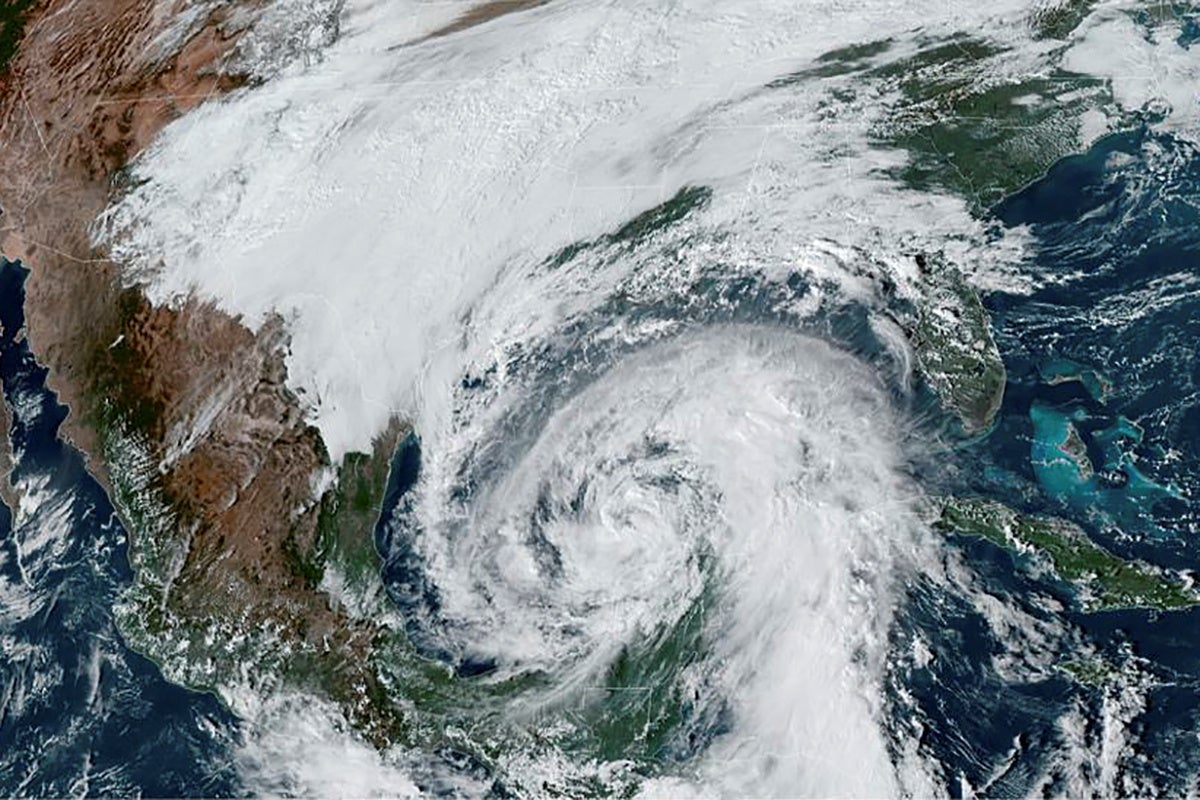Hurricanes staying at most destructive level for longer as planet heats up, study says
Hotter sea-surface temperatures are providing hurricanes with a larger ‘stock of moisture’, allowing them to wreak havoc for longer

Your support helps us to tell the story
From reproductive rights to climate change to Big Tech, The Independent is on the ground when the story is developing. Whether it's investigating the financials of Elon Musk's pro-Trump PAC or producing our latest documentary, 'The A Word', which shines a light on the American women fighting for reproductive rights, we know how important it is to parse out the facts from the messaging.
At such a critical moment in US history, we need reporters on the ground. Your donation allows us to keep sending journalists to speak to both sides of the story.
The Independent is trusted by Americans across the entire political spectrum. And unlike many other quality news outlets, we choose not to lock Americans out of our reporting and analysis with paywalls. We believe quality journalism should be available to everyone, paid for by those who can afford it.
Your support makes all the difference.Hurricanes are remaining at their most destructive level for longer as the world warms, a study has found.
Tropical cyclones tend to wreak the most havoc as they make landfall. Then, as they move over land, their intensity level typically decreases.
However, new research has found that, over the past six decades, storms in the North Atlantic have shifted towards staying at their highest level of intensity on land for longer.
Since 1960, the speed at which hurricanes “decay” after making landfall has slowed, the authors of the study say. This shift is likely linked to increases in sea-surface temperatures, they add.
“We show that hurricanes decay at a slower rate in a warmer climate,” study lead author Dr Pinaki Chakraborty, from the Okinawa Institute of Science and Technology Graduate University in Japan, told The Independent. The new research is published in the Nature journal.
“For North Atlantic landfalling hurricanes, the timescale of decay has almost doubled over the past 50 years.”
As hurricanes make landfall, they typically bring high winds and intense rainfall, which can cause severe damage through flooding. They can also bring deadly “storm surges”, a rising of the sea level that can lead to loss of human life and extensive flooding.
For the study, the authors analysed data for storms that made landfall over North America between 1967 and 2018 to examine changes to hurricane intensity.
The research found that, in the late 1960s, a typical hurricane lost about 75 per cent of its intensity in the first day after making landfall.
But by 2018, a typical hurricane lost just 50 per cent of its intensity in the first day after making landfall.
Through computer simulations, the researchers found that the slower decay of hurricanes is most likely linked to warming sea-surface temperatures.
This is because, as budding hurricanes form over the ocean, they use warm, moist air as fuel. An increase in sea-surface temperatures is providing hurricanes with a larger “stock of moisture”, the authors say, which is, in turn, allowing them to remain at their most destructive level for longer.
The researchers investigated whether other factors could have also contributed to the slowdown in hurricane delay time. They found that a smaller portion of the shift towards slower decay could be attributed to an eastward shift in the tracks of hurricanes forming in the North Atlantic. This too could be linked to human-caused global heating, Dr Chakraborty said.
“The authors’ work adds weight to growing concerns that tropical cyclones might become more damaging in the future,” Professor Dan Chavas and Dr Jie Chan, both from Purdue University, say in a comment article accompanying the new research.
It also “highlights a key component of risk models that has been largely overlooked so far”, Professor Chavas and Dr Chan say: “Slower storm decay after landfall in the future would directly result in increases in total damage, and this would be exacerbated by increases in peak wind speed and total rainfall, both of which are expected to occur in a warming climate.”
Previous research has found that, globally, major tropical cyclones have become 15 per cent more likely over the past four decades.
In addition, a second study published in 2018 found that the speed at which hurricanes travel across the Earth could be slowing down, allowing them to spend longer unleashing high winds and rainfall over land.
This year has seen a particularly turbulent hurricane season in the North Atlantic. On Monday evening, 2020 broke the record for the most named storms in a single season after Subtropical Storm Theta formed in the northeast Atlantic.
The 2020 hurricane season has so far seen 29 named storms. (Tropical cyclones are given a name if their wind speeds exceed 39 miles per hour (mph), at which point they become known as “tropical storms”. If their wind speeds exceed 74 mph, they are then given the name “hurricane”.)
The new research adds another dimension to scientists’ understanding of how the climate crisis is shaping hurricane risk, says Dr Chakraborty: “The message is dire: our research suggests that as the climate keeps warming, the decay of hurricanes will keep getting slower, and consequently, regions farther inland will face the wrath of ever stronger storms.”
However, it is important to note that the new study does not take into consideration how changing ocean heat content could also be affecting the intensity of hurricanes, Dr Kevin Trenberth, distinguished senior scientist at the National Center for Atmospheric Research, told The Independent.
“The authors fail to cite work that has shown that the ocean heat content is relentlessly increasing and breaking records year after year,” he said.

Join our commenting forum
Join thought-provoking conversations, follow other Independent readers and see their replies
Comments